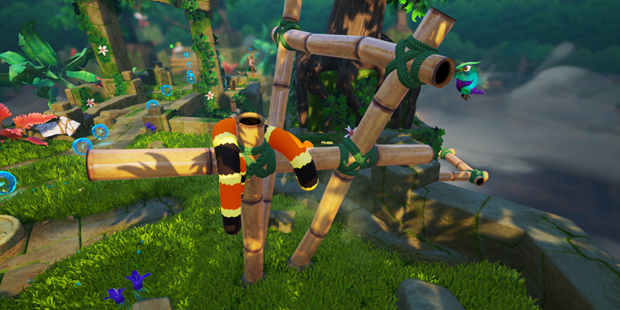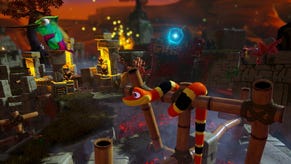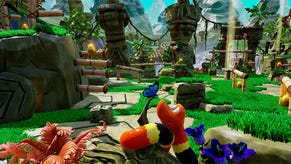Snake Pass and the unexplored territory of the game controller
Exsssssploring the controller
When we put up our review of Snake Pass [official site] I remember one of the comments asking about whether you can play the game on mouse and keyboard. It's an interesting question. The short answer is yes, but the longer answer is about how the developers, particularly Seb Liese whose tech prototype for snake movement started the whole ball rolling (or snake slithering), saw the controller in relation to the experience of playing. The way the input feels is intended to be a part of the whole experience – to the point where Liese was lobbying to ship without a mouse and keyboard option at one point because they hadn't found one which adequately expressed the same physical elements of playing.
This all came up because we were talking at Rezzed about controllers and games. In the case of Snake Pass the movement system was the thing the entire game hinged around. I'll add that generally, when I'm referring to controllers here I mean the Xbox 360 controller.
"When I first stumbled upon this movement system I felt like, 'Wow, this is something really different. This is something new,'" says Liese. "That is becoming really rare in the games industry - to run into something that is brand new and refreshing. That ignited my drive to push it and make it into something that really works and feels different and feels good."
I ask why that might be so and the answer is the one you might expect: a combination of people getting used to certain ways of thinking combined with the real financial risks of stepping off the beaten path. There's an understanding of why it might be harder to do offbeat things or to experiment.
"A large part of that is indeed thinking in frames. 'We're making a platform game or a 2D puzzle game or a [x] clone'. Also of course financial risks for companies to try to do something quirky or different. I think we can say we succeeded – our quirky thing is reasonably successful so far, but for every quirky idea that's successful there's probably ten other quirky ideas that are buried at the bottom of Steam that no-one ever runs into. So there's definitely risk associated with trying something different."
The point I really liked came a little later in the conversation. It's about how Liese believes there is still so much potential in the controller – "It's a simple device but I feel there are still so many unexplored things. You could use a controller in a different way."
It reminds me of the response I saw players have to Brothers – A Tale of Two Sons. It's about controlling two characters simultaneously and the controller becomes part of the emotional experience of the game. It's a rare moment of the input device suddenly becoming visible in a way that isn't just because it's malfunctioning or using an irritatingly awkward kind of button mapping.
Perhaps my fondness for this idea is because it otherwise only arises in the field of alternative controllers. But those occupy an area of their own, involving a strand of craftsmanship and experimentation and rethinking how we physically interact with games. That's not the same as looking at a 360 controller, a general-purpose device with an existing play vocabulary around it, and trying to consciously disrupt or adhere to it.
By that I mean, if the A button isn't going to be your main action and the left analogue stick isn't basic character movement in a 3D game you need a really good reason for it otherwise the game might feel lumpen and weird in the hands of anyone who has been using a controller for a while. Same as on a mouse and keyboard. If you have an open world and spacebar isn't jump and WASD isn't for movement, is that going to be disruptive for all the wrong reasons?
I like the idea of making a controller or a keyboard a conscious part of the experience of playing a game, in order to augment or change that experience. Another example is Keyboard Sports, which uses input as part of a system of puns as well as treating the layout as part of the game space.
To go back to the conversation with Liese, he added that "If you boil it down to the essence of what a videogame is, it's pressing buttons and seeing something happen because you pressed buttons and then your brain going 'ooh!'" He's interested in the other ways we might connect pressing buttons to "ooh!"
As part of the explanation he mentions juggling. It's something you have to concentrate to learn but once the muscle memory is in place there's a pleasure in that mastery of rhythm. I was part of my university circus skills club and never mastered juggling, but I did get good at poi. Poi is essentially about swinging tethered weights in patterns. Mine were beanbags on the end of lengths of cord with ribbon tails that would drag behind them. When I was learning I used pop socks with tennis balls jammed into the toes because they were easier to deal with than tangled ribbons.
The poi would end up in a muddle or I'd smack myself in the side of the head as I figured out things like a five beat weave but at some point – one I couldn't pinpoint if you asked me to – it switched over into being this automatic thing and my hands knew what felt right and wrong. Even now, over a decade since I last really did any meaningful practice I can pick them up and feel my way back to competence. It feels wonderful. Fluid and familiar and comfortable. I'd forgotten that pleasure of movement.
Anyway. Back to Snake Pass again.
"The controller has been, from the beginning, almost the starting point and the end point of the design," says Liese. "How do we make this work on an actual controller? Which is why I'm quite sad that we even have the option to play on PC with mouse and keyboard. I was really fighting to not even have the option in. That was my point of view but in the end we had to put it in."
The way he explains this resistance, it isn't because you're wrong if you play it on mouse and keyboard, it's because it removes something very particular from the game that Liese feels is a valuable part of the experience.
I ask whether there was anything the team could do in terms of using different combinations of keys or some other approach to approximate the same effect, or perhaps create a new one.
"We tried many different approaches to map this controller input to the keyboard. The one we have now sort of works but for me it feels like it has lost quite a bit of that translation of your input to what's happening on screen."
But he adds that he has also been surprised by how adept people have been in playing via mouse and keyboard:
"To my surprise we managed to get something that is actually very playable. There are loads of people who have already finished the game using keyboard and mouse which I thought was going to be very difficult. I guess when you learn the game using that input system it's different."
And that is the long answer to whether there's a mouse and keyboard option for input.









